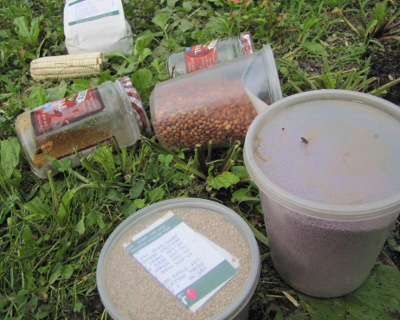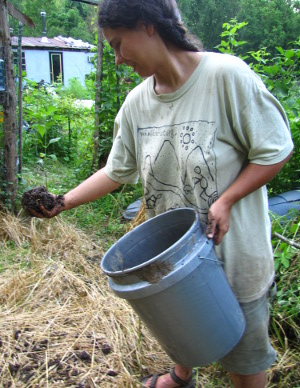
Seed ball experiments
 So now that I've told you the
hows and whys, I can finally share my own seed
ball
experiments. My goal was to plant the summer and fall crops in
the do-nothing
grain area at the
same time that I refreshed the clover population. For our winter
grain, I opted to switch over to rye, and my new summer grains include
field corn, oilseed
sunflowers, amaranth, and pearl millet.
So now that I've told you the
hows and whys, I can finally share my own seed
ball
experiments. My goal was to plant the summer and fall crops in
the do-nothing
grain area at the
same time that I refreshed the clover population. For our winter
grain, I opted to switch over to rye, and my new summer grains include
field corn, oilseed
sunflowers, amaranth, and pearl millet.
I wanted to keep each
type of summer grain separate, so I made four different mixtures ---
sunflower/rye/clover, amaranth/rye/clover, millet/rye/clover, and
field-corn/cowpeas/rye/clover. You'll notice that the corn
mixture is a little different since I added cowpeas to give this heavy
feeder an extra dose of nitrogen.
 I also wanted to know whether
seed balls are really any better than the lower work method of just
mixing up the ingredients and scattering the dirt/seed mixture amid the
wheat stubble. So, all told, I had eight experimental treatments
--- corn/rye/clover balls, corn/rye/clover mixed into loose earth, etc.
I also wanted to know whether
seed balls are really any better than the lower work method of just
mixing up the ingredients and scattering the dirt/seed mixture amid the
wheat stubble. So, all told, I had eight experimental treatments
--- corn/rye/clover balls, corn/rye/clover mixed into loose earth, etc.
Real conclusions will
have to wait a few weeks, but I already have a few observations.
First, I haven't seen any wild birds chowing down on my seeds, which is
a bit surprising since lots of seeds are visible on the outside of the
seed balls and in the loose earth mixtures. Even more exciting,
the seeds are already sprouting! Field corn may be a bit of a
problem in a seed ball since the kernels are so large that they tend to
fall out of the earth mixture and
sit on the wheat stubble, but clover and pearl millet leaves are poking
up through the dirt. I have high hopes that the other seeds will
soon follow suit.
| This post is part of our Seed Ball lunchtime series.
Read all of the entries: |
Want more in-depth information? Browse through our books.
Or explore more posts by date or by subject.
About us: Anna Hess and Mark Hamilton spent over a decade living self-sufficiently in the mountains of Virginia before moving north to start over from scratch in the foothills of Ohio. They've experimented with permaculture, no-till gardening, trailersteading, home-based microbusinesses and much more, writing about their adventures in both blogs and books.
Want to be notified when new comments are posted on this page? Click on the RSS button after you add a comment to subscribe to the comment feed, or simply check the box beside "email replies to me" while writing your comment.
